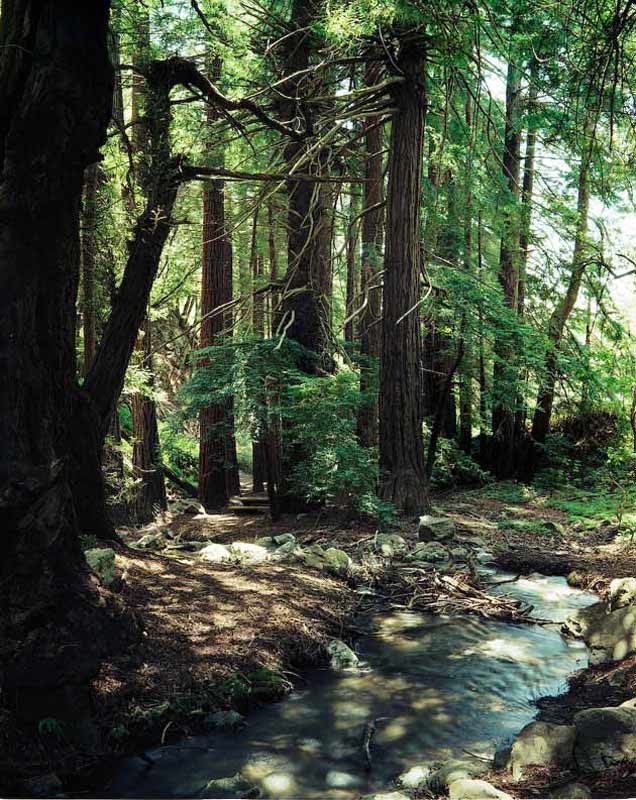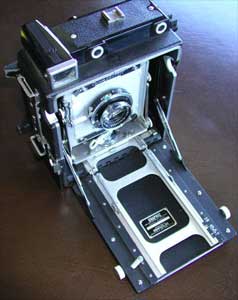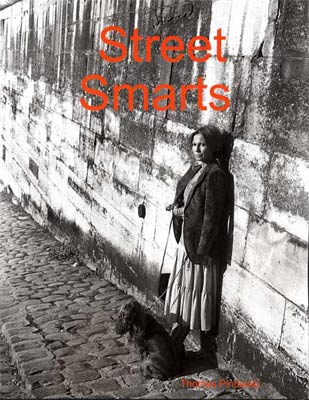So I arrive at my Top Secret Highway One location on California’s magnificent coastline with my ‘new’ Crown Graphic and its Schneider Xenar 135mm f/4.5 lens. My Linhof tripod, sturdy but weighty, in a Scottish Tartan bag over my shoulder, the tripod some two inches longer than the bag with the latter’s microscopic strap cutting through my shoulder. Add to this the fact that my prized new Crown is wrapped in an old black terry cloth towel, my initials still proudly stitched in its corner, with two rather tired wooden film holders chucked in a bag emblazoned with an ‘LA Rams’ logo, and you will correctly conclude that this picture taking trip was something less than D Day in its level of preparation.
I had somehow managed to locate my Weston Master V exposure meter. More surprisingly, it checked out well against any number of other scientific devices in the household, despite being on its second selenium cell. I have owned it 35 years, having bought it new. Adding accident to good fortune, I had actually remembered to bring along my pristine, new, $5 12†cable release, a famous General Brand no less from B&H, or I would not have been able to manage a steady shutter release at the long exposures called for. At least it said Made in Germany on the box. A Schneider lens would accept nothing less.
Let’s see, what else? Oh! Yes, the 8x Schneider loupe I use to check negatives finally afforded me the opportunity of attaching the lanyard to its ears, thus ensuring that I would be mistaken for Steven Spielberg or, at the very least, Richard Attenborough (on account of my Harris Tweed cap), on my trek through the redwoods, the loupe dangling in a cavalier manner from my neck and bouncing suggestively on my manly and heaving chest.
And heave it did, for I soon found myself struggling up a trail made by the Chief Sadist at the National Park Service, its angle to the horizontal at least 45 degrees, as I aimed the LA Rams bag this way and that to avoid a nasty crack on any number of rocks that planned unprovoked attack on my precious Crown, the while struggling to keep the wretched tripod bag on my shoulder.
In other words, my packing of the large format kit needs some work.
After more of this than I care to remember, I arrived at the destination I had dutifully scouted out not three days earlier. Living in proximity to Highway One and all its magic allows no excuses for ignorance of the territory. By the time I got to the waterfall of choice, deep in the redwood forests of coastal California, three things were evident:
1 – The cardiac arrest profession would stay in business
2 – A Harris Tweed cap has pretty poor venting for an overheated head
3 – Doing this without a copious supply of martinis in the car cooler is foolish, nay, life threatening.
So on to the business of taking pictures.
First, I checked the immediate vicinity, say 100 miles in all directions, to confirm no one would be around when I dropped the camera/pulled the film holder from the camera with the dark slide in the other hand/slipped in the mud with tripod in close pursuit. There’s only so much embarrassment a fellow can take.
Then, having presciently placed quick release plates on both the Crown’s tripod sockets, it was a matter of moments to change from landscape to portrait orientation, previewing matters in the Crown’s decent optical finder.
I had left the rear hood for the ground glass at home, preferring to check focus with the Schneider loupe (Spielberg Edition), not least because my eyesight is so poor that any hope of focusing without a loupe would be akin to hoping for a date with Sophia Loren. Composition was easy as I have developed the knack of pre-visualizing the field of view of a 35mm lens on my Leica after years of use in the streets. The 135mm on 4×5 is just a little narrower than the Leica’s 35mm.
Using the old cloth towel confirmed that it was too small, and even then things kept getting steamed up in there as copious amounts of moist vapor emanated from my fevered skull. No one told me you had to take a 5 minute break before focusing a field camera. I also learned it is very tricky to try and focus while keeping your Harris Tweed cap in place, so sartorial compromises had to be made in the pursuit of Art. I chucked the cap on the ground.
Once I cooled down, everything was fine. Focus at the f/4.5 maximum aperture was, literally, a snap once I remembered to open the lens (you cock the shutter, move a little button lever on the lens mount towards the film plane, then release the shutter) and easily confirmed with the excellent coupled rangefinder on the Crown which I had taken pains to align before setting out. Indeed, it has to be said that the ground glass added little value to this effort other than forcing me to think upside down. The optical viewfinder is accurate and parallax corrected down to six feet. If all else fails, the erectable sports finder is close enough and gives, goodness knows, a life size image as there is no glass anywhere in sight. It too is parallax corrected – you move the eyepiece up and down on a calibrated scale.
Now I’m trying to recall my mental check list. I have the composition down and the lens focused. Things are reasonably secure on the Linhof which is sporting a Leitz large ball and socket head, which seems perfectly adequate given the light weight of the camera. Close the shutter. Important step that. Insert the film holder, praying once more that I loaded the film correctly, notches to the top right of the dark slide as you face the to-be-exposed surface.
Now for some Zone stuff. I should point out that ever since I read about it as a kid over 40 years ago, that the Zone System struck me as the biggest piece of bunk since Social Security. God alone knows how many great pictures have been missed as Zonies did their arcane computations. It did sell a lot of books, I suppose. With my Weston, about as non-directional a device as you can find, my system, soon to become renowned as the Modified Zone system and the subject of a thousand page monograph, is far simpler. I will disclose it here at no cost to the reader, although signed copies of the first edition of the monograph, with a limited printing on one million copies, will be available shortly at $99.95 each.
Ready? You point the Weston at the darkest bits you want to come out. The needle says 6.5. You point it at the lightest parts you want detail in. The needle says 9.5. You take the average. 8.0. Twiddle the dial and you get 3 seconds at f/32. Use negative rather than slide film and you gain latitude for error. I added a second for luck and for reciprocity failure.
Insert the cable release. Set the aperture to f/32, the shutter to B, tension the shutter.
4 seconds? Wait a moment. I have never used anything slower than 1/15th. Oh! Now I remember. This is from the smelly, foul chemical filled darkroom days. Quite literally the Dark Ages of photography.
Elephant 1. Elephant 2. Elephant 3. Elephant 4.
Reinsert dark slide the other way around to remind you the film is exposed (I hope) and twiddle the little lock thing on top to prevent that side ever being used again. Pull the film holder. Collapse exhausted.
I have just taken my first ever 4×5 photograph at the tender age of 53.
And here it is:



